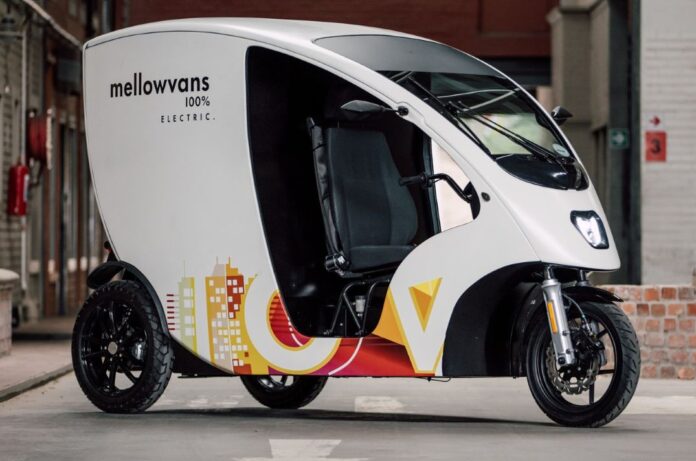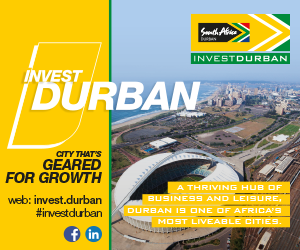Last-mile delivery solutions are being sought everywhere as e-commerce continues to grow. Some food retailers have backed old-fashioned motorbikes and some are powering their delivery trucks with electricity, but a Stellenbosch-based company is shaking up the sector with an electric three-wheeler that looks a bit like a taxi you might expect to see on a busy street in Hanoi.
MellowVans already has an impressive list of clients that includes DHL, DOCKR, OK Online, takealot, DPD and Spar. With a carrying capacity of 2 500 litres and a range of about 130km on a single charge, the vehicle offers versatility and low running costs. Although the company did not qualify to be part of the country’s automotive industry support programme because it does not produce in sufficiently high volumes, export markets have opened up in Europe, Egypt and the Middle East.
With the Post Office barely functioning, a rising trend in South African has been the growth of parcel-delivery options. A plethora of companies have sprung up to join the established DHL, DSV, PostNet and RAM Hand-to-Hand Couriers, which runs a fleet of 1 600 vehicles. These include Pargo, which has more than 4 000 pickup points around the country, The Courier Guy and D2D. Some companies have taken space in service stations to place dedicated lockers for the delivery and collection of parcels.
Transnet received a loan of R18.2-billion from the African Development Bank in the course of 2024, a signal from the world of finance that efforts to fix the state-owned logistics and freight company are credible. The cost to fix Transnet Freight Rail has been estimated at between R150-billion and R200-billion so there is still some distance to go but a Freight Logistics Roadmap and other planning initiatives suggest that the state and the company are serious in their intent.
Transnet Freight Rail is carrying more cargo.
The CEO of the African Rail Industry Association (ARIA), Mesela Nhlapo, has praised the utility for the “open and transparent manner in which it is managing the rail-reform process”. A recovery plan was adopted in October 2023 and by November 2024 freight volumes had grown by four-million tons with the aim of reaching 170Mt by the end of the 2023/24 financial year.
Revitalising and getting value out of under-used or defunct branch lines, which often used to be the only way of getting a commodity out of a farming or mining district, will be a key indicator of progress. The first round of attempting to get the private sector to invest floundered so getting it right second time around will be especially important.
South Africa has 22 000km of railway lines and 747 000km of roads, 325 019 heavy-load vehicles and the road freight industry employs 65 000 drivers. There are 135 licensed airports in the country, 10 of which have international status. The South African Department of Transport has several agencies and businesses reporting to it. Among them are Air Traffic and Navigation Services Company, Airports Company South Africa (ACSA), National Transport Information System, Road Accident Fund, South African Civil Aviation Authority, South African Maritime Safety Authority (SAMSA), South African National Roads Agency Limited (SANRAL) and Passenger Rail Agency of SA (PRASA).
Planning is key
In the Western Cape, the administrations in charge of the City of Cape Town and the province have plans to better coordinate transport. The City of Cape Town has conducted a feasibility study on taking over the management of passenger rail services from PRASA. The city wants to have a fully-integrated system, which would include rail. The city’s Urban Mobility Directorate published an updated Comprehensive Integrated Transport Plan (CITP), and has strategies and plans for improving the transport environment in the metropole. The Transport and Urban Development Authority (TDA), located within the municipality, is responsible for planning, costing, contracting, regulating, monitoring, evaluating, communicating, managing and maintaining the City of Cape Town’s transport infrastructure, systems, operations, facilities and network. The provincial government has followed the city’s lead with the establishment of a Mobility Department.
Large amounts of money are to be spent on various forms of public transport in the short term. Investments in rapid transit systems in the big metropolitan areas such as Johannesburg are being followed by cities such as Polokwane and Rustenburg. In Limpopo’s provincial capital of Polokwane, operations of the Leeto La Polokwane public transport system were launched in 2021 while Johannesburg’s Rea Vaya has been running since 2009.
There are plans to make more use of Hoedspruit Airport, the airport that is most often associated with the Orpen Gate of the Kruger National Park. In 2022, 61 000 of the people who passed through Hoedspruit were European tourists but there is potential to increase this traffic substantially. CemAir offers flights to Johannesburg and Cape Town and Airlink connects to destinations such as the Victoria Falls in Zimbabwe, Maun in Botswana and Vilanculo in Mozambique. The Limpopo Department of Transport and Community Safety is working on a strategy to develop the airport to further boost the tourism sector.
The Polokwane International Airport (PIA) is wholly owned by the provincial government and run by the Gateway Airports Authority Ltd (GAAL), an agency of the Department of Transport. It has the potential to be an important regional cargo airport.









